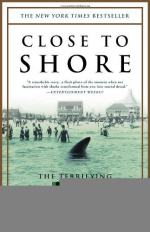
|
| Name: _________________________ | Period: ___________________ |
This test consists of 15 multiple choice questions and 5 short answer questions.
Multiple Choice Questions
1. The editorial noted that people had an unnatural ___________ sharks.
(a) Power over.
(b) Fear of.
(c) Anger toward.
(d) Interest in.
2. On board were the architect Stanford White, New York Sun publisher Charles Dana, and close friend ___________________.
(a) Franklin Delano Roosevelt.
(b) Andrew Carnegie.
(c) Theodore Roosevelt.
(d) J.P. Morgan.
3. The Vansants stayed at the stylish _____________ Hotel, where the upper crust enjoyed their respite.
(a) Engleside.
(b) Essex.
(c) Edmonton.
(d) Eagles Nest.
4. The shark had traveled ____________ miles north from Beach Haven.
(a) Twenty.
(b) Forty.
(c) Thirty.
(d) Fifty.
5. The hotel manager, ___________________, immediately ordered his telephone operators to notify the operators in all the hotels on the north and central coast.
(a) Damian B. Parsons.
(b) David B. Plumer.
(c) Darrel B. Pickering.
(d) Daniel B. Plickard.
6. The first to reach Charles was who?
(a) The hotel manager.
(b) His fiancee.
(c) His father.
(d) Alexander Ott.
7. What had appeared in the paper about the attack?
(a) Some information in the middle of the paper.
(b) A small article on the back page.
(c) Nothing.
(d) An article on the front page.
8. Successive rows of additional teeth are poised behind the functional teeth, ready to replace them when they are discarded. Every ______________ weeks, a new, serrated set of teeth replaces the current set.
(a) Two or three.
(b) Five or six.
(c) Three or four.
(d) Four or five.
9. What did Charles Bruder want to do?
(a) He wanted to outdo Dowling's recent swim.
(b) He wanted to swim with the shark.
(c) He wanted to go surfing.
(d) He wanted to catch the shark.
10. ______________________ of working-class men and women migrated across downtown Philadelphia to the coast on the first day of July 1916.
(a) Thousands.
(b) Millions.
(c) Hundreds.
(d) Dozens.
11. The shark that attacked in 1916 had returned from the southern waters where he had suffered in his competition with many larger predators. He was tossed northward by what?
(a) A tropical storm.
(b) The strong current of the Gulf Stream.
(c) The smell of humans.
(d) A strong hurricane.
12. What did the swimmers do after they learned what danger they had been in?
(a) They changed their vacation plans immediately.
(b) They ignored the information.
(c) They went looking for the shark.
(d) They decided to go for another swim.
13. The great white, even in modern times, remains what?
(a) Much of a mystery.
(b) Of no interest to man.
(c) A significant danger to man.
(d) A creature of interest.
14. The only known creatures that on rare occasions are known to attack great whites of this size are what?
(a) Larger great whites, sperm whales and orcas.
(b) Seals and dolphins.
(c) Dolphins, sperm whales, and larger great whites.
(d) Blue whales and orcas.
15. Though young sharks can seem slow-moving, when stimulated they can reach speeds of ____________ miles per hour.
(a) Twenty.
(b) Seventy.
(c) Thirty.
(d) Fifty.
Short Answer Questions
1. What might have been the reason for the hotel to keep down word of the incident?
2. For what was the shark waiting?
3. The _______________ Hotel's young bell captain, Charles Bruder, decided to slip away for an afternoon swim.
4. As Gertrude stroked along parallel to the coastline, what happened to her?
5. There were some ______________ people in the water the day following the attack on Charles Vansant.
|
This section contains 575 words (approx. 2 pages at 300 words per page) |

|




